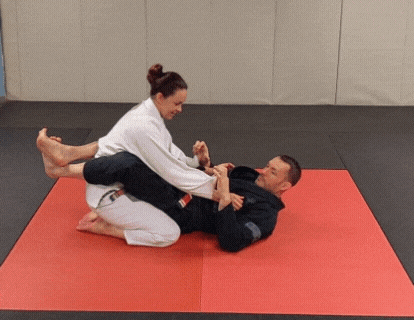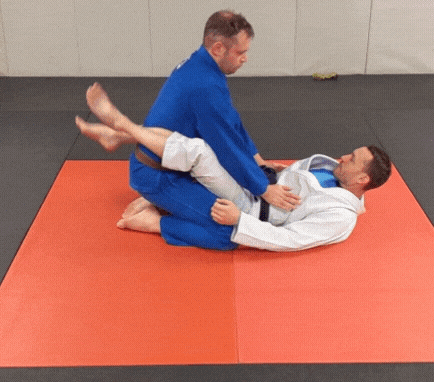Click here for Part 2 and Part 3.
The term Omoplata is most commonly translated to ‘shoulder blade’ although I have heard other things as well. It is a leg over shoulder lock which uses one of the strongest motions the human body is capable of, hip extension, to attack one of the weakest, shoulder rotation. It is a submission, a sweep, and a control position all in one. Let’s dive in.
Basic Omoplata.
There many different entries to the omoplata, some of which we will look at here, but there are far too many for me to make an exhaustive list. Instead we will only look at the ones we discussed in class.
The basic closed guard omoplata begins with a cross grip, our right hand to their right sleeve. You can grab the wrist, but if they are in a jacket, the sleeve is better. Next we underhook their leg on the same side, in this case my left hand to their right leg. Opening our guard, we use the underhook to help us swing 180 degrees until we reach the playing card shape with our head by our opponents feet and theirs by ours. The main objective while doing so is to connect our hip as high into their shoulder as possible. At this point is it also necessary to ensure we have trapped the wrist we are gripping on our inside hip,not across our body to our outside hip. It is often shown to triangle our legs at this stage but, it is not strictly necessary. It depends on how we intend to proceed. If we want to finish our submission, we should look to switch our leg grip to a grip on their back. The belt can be useful here. This grip serves two purposes, it helps us sit up, and it helps prevent their escapes. So the transition needs to be quick. Once we can sit up, to finish we want to triangle our legs if had done so earlier, and point both of our feet away from our opponent in the ‘S’ or ‘octopus’ shape. From here we dive the top knee toward the mat, as we extend our hip upward. Our hips motion upward will take their wrist with it behind their back applying a similar force to a kimura. Depending on their flexibility they may tap early or late so be careful. The lock is best applied when they are laying flat on their stomach, but it can be completed with a little more effort if they are still on their knees.
Basic Omoplata finish.
Entry from Williams guard
Below is the entry we looked at from the Williams guard recently. Beyond requiring less space than the above example, it is otherwise the same. Note, it is just the entry and not the finish. Read more detail on the Williams guard here.
Omoplata from Williams Guard
Entry from leg Lasso Spider Guard.
The omoplata is one of the main attacks from the leg lasso position. Beginning in closed guard we acquire a double sleeve grip. Opening our guard and shrimping, we take one foot outside and loop it over then under the arm we wish to trap. We then rotate our knee back out so that the sole of our foot is on our opponents ribs. This puts pressure into the bicep with our shin, and allows us to direct force into the shoulder. Ideally we want to keep their hand trapped on the near side of our thigh to make the grip even harder to break. On the other side we place our foot on their bicep and extend our leg. This is the basic lasso position. From here there are several omoplata entries posible, some requiring an inversion, some not. The example below is more direct. Releasing our grip on the lasso side, we reach up and regrip at the elbow. Pulling it close at the same time as we extend our leg allows us to kick deep behind the arm. On the other side, pressure with the foot on bicep moves the opponent away and allows us the base we need to do a partial rotation. Reaching for the back as well as releasing the foot on bicep grip so that we may shrimp off the mat instead will allow us to finish our rotation.
Omoplata from Leg lasso Spider Guard
Entry from Knee shield
When playing knee shield, a common problem we can encounter is an opponent lacing their arm under our top knee and over our bottom knee to set up a pass. This is a strong pass and a good idea on their part, but it is not without counters. One option is to enter the omoplata in a similar manner to the lasso guard above. Gripping the laced arm at the elbow and pulling it toward us, we want to scissor our legs with the top knee moving back and bottom knee moving forward. With enough pressure this should clear the lace, and on doing so we will find ourselves able to bring our top leg once again over the shoulder.
Omoplata from knee shield
Rolling Entry from a poor single leg
Wrestling to a single leg is a big part of grappling. It comes up a lot and is very useful. However, if done poorly it can be countered with the omoplata. In the example below, Maria attempts to use a single leg as an escape from bottom side control. She bridges, turns in and collects the leg while getting to her knees. So far so good. However, if when wrestling up on the single, she spends too much time in this position, and specifically, she leaves her elbow on the mat between my calves, she is vulnerable to the rolling omoplata entry. Had she kept her hands clasped but brought her forearm over my calf, or stepped her inside leg over mine instead, this counter would not work.
Rolling omoplata against single leg
As the top player, to enter the omoplata here is simply a matter of rolling over our inside shoulder. It can be helpful to reach down and grip the elbow before rolling, so that they are unable to correct their mistake.
Entry from mount.
One of the first things we learn to do from mount is to isolate the bottom player’s arms with our knees. If we are able to work our knee between their elbow and their body, an omoplata is possible. Connecting our own elbow to our knee to trap their arm inside, we lift the knee off the mat and extend the foot forward. Turning then toward their trapped arm, we grip the elbow to force it to rotate into a thumb down position, and lift our extended leg over their head forcing them to roll to their belly, posting our other hand on the mat for base and power. Omoplatas of this type are especially strong as the opponent will usually land flat on their stomach or flank and not on their knees, making it harder to defend.
Omoplata from mount
As a side note, inexperienced grapplers will sometimes panic when mounted and clasp their hands around the top player’s waist. This is not a good idea, but it can be frustrating as it does limit the top player’s movement. The omoplata works well here.
Rolling entry from mount
In some circumstances it can be hard to force the bottom player to roll to their belly. If there is a size discrepancy for example, it can be helpful to have more momentum and power for the roll. In that case we can use a slightly more complicated roll. Beginning as before, once we have the arm trapped and our leg extended, instead of pulling our leg over their head, we lean forward and fall to our back in the opposite direction as the previous example. From here we stomp our feet toward the mat, forcing our opponent to sit up and assume the more standard omoplata position. This is a much stronger motion than the one above, but, our opponent is much more likely to be on their knees at the end, allowing them more options for defense.
Rolling omomplata from mount
Alternative finishes
As I mentioned above, the omoplata is a control position in addition to being a submission itself. Some people prefer to check down to other finishing options right away, others only do so when struggling to finish the shoulder lock itself. These two options are both things you can choose to do, they may act as counters to your opponents escape attempts, but they don’t require them. There will be more on counters to specific escape attempts later in this post.
Collar choke.
To apply the collar choke from the omoplata our arm closest to our opponent, the one already on their back reaches across to become an underhook. Here, it should find the lapel and prep it to be handed off. Next we reach under their chin and receive the lapel with our other hand. The underhook hand then snakes behind the head as in the style of a single wing chokes. In the example below, Maria postures up, this makes finishing the shoulder lock harder, but allows us to apply the choke as seen. If the opponent does not do so, and stays on their knees, it is often difficult to pass the underhook hand behind the head as shown, in which case it is best to just maintain it as an underhook, more like a clock choke.
Collar choke from omoplata
You can also check out this video of Mackenzie Dern applying a jacketless version in mma.
Toe hold
Being on their knees gives our opponent more leverage to resist and options for escape, but leaves their feet within reach. With our inside hand, we want to reach back and cover their pinky toe with the largest knuckle of our middle finger. Our outside hand then reaches over then under the leg to grip our own wrist. Hugging the leg tight, we attempt to do an abdominal crunch, forcing our opponents big toe… well… up their butt. There is no better way to say it. Keep in mind you do not want to extend your arms away from your body, instead you want to hug the ankle tight and power the move with your core.
Toe Hold from Omoplata











